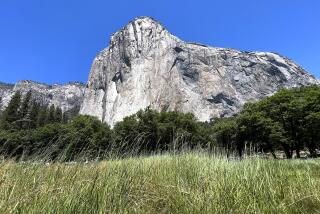U.S. Orders Elimination of Smog Over National Parks
- Share via
Smoggy skies that shroud Yosemite, the Grand Canyon and dozens of other national parks will eventually have to be cleaned up under federal environmental regulations announced Thursday.
The plan orders that the skies over the parks be returned to the clarity of pre-industrial times, but it gives states 65 years to reach that ambitious goal.
Vice President Al Gore announced the plan at Shenandoah National Park in Virginia, saying: “We will restore pristine skies, so future generations can see the Grand Canyon, Half Dome and the Great Smoky Mountains just as the first explorers did.”
Many environmentalists appear generally pleased with the proposal, although some expressed concern that the cleanup will take so long. Some utilities with coal-burning power plants, meanwhile, said the goals might be difficult and costly to meet.
Just how states and regional alliances will rid the skies of smog, smoke and soot remains to be seen, since specific plans for cleaning the air are not due for at least four years.
Between 2003 and 2008, states must submit the first of regular 10-year plans toward meeting the final clean air goal. Many of the recommendations will be national in scope. Air quality in all of the parks listed for haze reduction efforts would benefit, for instance, by federal EPA regulations, set to take effect in the next decade, that reduce pollutants from trucks.
Regional air agencies or states also might put stricter emission limits on utilities and smokestack industries, in some cases far from the affected parks.
In the case of the Grand Canyon, for example, 21% of the man-made haze comes from the Los Angeles area, according to past estimates.
Closer to the parks themselves, it is possible that states would have to require fewer automobile trips and, perhaps, limit the number of campfires, EPA officials said.
Congress first ordered the plan to clean the skies over America’s parks when it renewed the Clean Air Act in 1977. But the EPA took more than two decades to draw the rules for the cleanup, in large part so that the agency could perfect its ability to measure visibility.
The agency now reports that visibility in many parks is more than cut in half on the poorest air quality days.
One can see for up to 132 miles from some locations in Yosemite on a good day, for example, compared to just 41 miles on a bad day. Visibility in the Grand Canyon can drop from 128 miles on a good day to 68 miles on a bad one.
The environmental agency has told California to clean the air at 29 parks and wilderness areas including Yosemite, Joshua Tree, Lassen, Kings Canyon, Point Reyes and Sequoia.
To do so, the state Air Resources Board is expected to follow the lead set by a Grand Canyon agency that has served as a pilot project for creating regional plans to clean the air.
Eight states and four Indian tribes in the West reached an agreement three years ago to reduce haze in the canyon by 10%. The plan by the Grand Canyon Visibility Transport Commission was heralded for bringing together such a large and contentious group. Yet many of the details of how the alliance will cut air pollution remain to be worked out.
The Clinton administration also announced plans Thursday to seek $1 billion this year and next to preserve farms, urban parks, seashores and other open space. The spending would require the approval of Congress.
More to Read
Sign up for Essential California
The most important California stories and recommendations in your inbox every morning.
You may occasionally receive promotional content from the Los Angeles Times.














